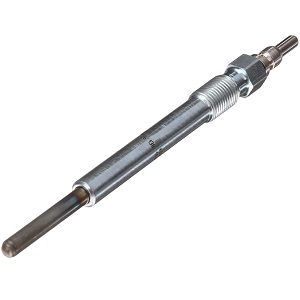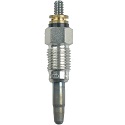
Function Of Glow Plugs
Since it is relatively difficult to ignite the air/fuel mixture in a diesel engine, and especially when the engine is cold, diesel engines are fitted with a glow plug in each cylinder that serves as an additional source of heat-on-demand to assist with initiating ignition of the air/fuel in cold diesel engines. In essence, they serve a similar function to a spark plug in a gas engine, however glow plugs only operate at certain times (such as when a diesel vehicle is cold).
On older vehicles, the glow plug control circuit typically feeds a current to the glow plugs through a relay when the ignition is tuned on. The glow plugs typically operate on a timed interval (e.g. for the first two minutes after vehicle start up), such that the glow plugs are operational only the vehicle is cold, but deactivated when the vehicle is warm.
Modern engines with modern engine control software control far more parameters related to glow plug operation, which results in smoother running with better fuel efficiency and component longevity, but the basic operating principle still remains similar.
Common Symptoms Of Faulty Glow Plugs
It should be noted that it would be exceedingly rare for all the glow plugs on an engine to fail at the same time (although they are typically replaced as a set). In practice, this means that if all the glow plugs in a vehicle seem to be inoperable, the fault is more likely related to other systemic issues such low system voltages, defective wiring, defective relays, blown fuses/fusible links, timers, or the glow plug control module.
That said, some common symptoms of failed or failing glow plugs could include the following:
No Start Conditions
Since the combustion process on a cold engine depends on the heat supplied by the glow plugs, the engine may either not start at all, or it may only start after extended periods of cranking.
Warning Light On Dashboard
This can be a dedicated glow plug warning light or a more general check engine light, depending on the vehicle.
Excessive Smoke On Cold Start
If the engine cranks for longer than usual due to inoperable glow plugs, enough fuel may accumulate in the cylinders to produce dense clouds of smoke when the engine does start.
Battery And/Or Starter Motor Failure
Since it takes a lot of power to crank a diesel engine due to their extremely high compression relative to gas motors, extended cranking can drain a battery relatively quickly or damage a starter motor though overheating of the motor.
Replacing Glow Plugs
Replacing glow plugs is relatively simple job that should be well within the capabilities of most non-professional mechanics. That said, to give you a basic idea of how involved the job is, a high level overview of the replacement procedure is described below.
Note: The example steps below are intended for general informational purposes solely to help give you an idea of project difficulty and tools required. As all cars are engineered differently, repair procedures and safety hazards vary from vehicle to vehicle. To ensure that you have a vehicle specific repair procedure and an exhaustive list of potential safety hazards, we advise you reference a factory service manual for your vehicle. Similarly, referencing a repair manual such as Chilton or Haynes might serve as a less expensive alternative.
Step 1 – Make sure the engine is cold, and that the ignition is in the “OFF” position. If required, remove all cosmetic engine covers and shields to gain easy access to the glow plugs. Sometimes this requires a set of small screwdrivers to remove the fasteners holding them in place. Depending on the vehicle, you may also need to remove the valve cover. If this is the case, it’s a great time to replace your valve cover gasket since you’ll already have most of the work done.
Step 2 – If the vehicle uses unit injection, look for a flat bus bar running the length of the cylinder head(s) that connects all the glow plugs together. Using a suitable socket from your mechanic’s tool set, remove the small nuts that hold the bus bar onto each glow plug, place them safely aside, and remove the bus bar.
If the vehicle uses common rail injection, look for leads that resemble spark plug leads on gasoline engines. These leads feed power to the glow plugs from the glow plug control module, and they can simply be unclipped from each glow plug. Take note of which lead goes to which plug, to make sure you reconnect the correct lead to the correct glow plug.
Step 3 – Using a glow plug socket (often times you can get by with a spark plug socket), unscrew one glow plug and extract it from the cylinder head. Insert the replacement, but use your fingers to tighten it into the cylinder head for the first few threads to prevent cross-threading, which could damage your engine’s cylinder head resulting in costly repair. Repeat this process for all the other glow plugs, but be sure to tighten all glow plugs to their recommended torque values using a properly calibrated torque wrench. The glow plug manufacturer typically provides appropriate torque values in the packaging for the glow plug. If in doubt, consult your factory service manual for your vehicle.
Step 4 – For vehicles with unit injection, replace the bus bar, but be extremely careful to prevent over tightening of the small retaining nuts that hold it on to prevent damaging the new glow plugs. For vehicles with rail injection, replace the leads and make sure to connect them in the same order they were before you disconnected them.
Step 5 – Verify everything is installed and connected correctly, and then replace the engine covers.
Best Glow Plug Brands
When it comes to choosing a set of glow plugs, there are tons of options out there. In order to make your life a bit easier, we have listed our recommendations for the best glow plug brands below to save you some time.
Motorcraft
 Motorcraft glow plugs are designed specifically for Ford applications, and are therefore the recommended replacement brand for Ford applications, since Motorcraft glow plugs that are supplied to the aftermarket are similar to Ford’s OEM equipment. Motorcraft glow plugs have good quality and will likely provide reliable operation for many years on Ford applications. This makes Motorcraft glow plugs an easy choice if you drive a Ford.
Motorcraft glow plugs are designed specifically for Ford applications, and are therefore the recommended replacement brand for Ford applications, since Motorcraft glow plugs that are supplied to the aftermarket are similar to Ford’s OEM equipment. Motorcraft glow plugs have good quality and will likely provide reliable operation for many years on Ford applications. This makes Motorcraft glow plugs an easy choice if you drive a Ford.
Click here to find Motorcraft glow plugs for your vehicle.
NGK
 NGK is widely regarded as the world’s leading manufacturer of glow plugs, and their several proprietary technologies allow diesel engine engineers to easily meet emissions regulations. NGK supplies glow plugs for almost every vehicle brand on the world’s roads today. Thus, no matter what you drive, NGK can supply glow plugs that will start your engine reliably and consistently in a variety of operating conditions. As such, we think you will be satisfied if you choose to use NGK for your next replacement.
NGK is widely regarded as the world’s leading manufacturer of glow plugs, and their several proprietary technologies allow diesel engine engineers to easily meet emissions regulations. NGK supplies glow plugs for almost every vehicle brand on the world’s roads today. Thus, no matter what you drive, NGK can supply glow plugs that will start your engine reliably and consistently in a variety of operating conditions. As such, we think you will be satisfied if you choose to use NGK for your next replacement.
Click here to find NGK glow plugs for your vehicle.
Bosch
 Bosch manufactures and supplies standard, low-voltage, and ceramic-sheathed glow plugs for almost every diesel vehicle make and model on the road today. Bosch is also the leading supplier of glow plugs for both the European OEM and aftermarkets, and has a long standing history of making a variety of electric auto components ranging from sensors, to gauges, to spark plugs. Bosch build quality is great, and we are confident that you will be happy with your decision if you use a set of Bosch glow plugs for your project.
Bosch manufactures and supplies standard, low-voltage, and ceramic-sheathed glow plugs for almost every diesel vehicle make and model on the road today. Bosch is also the leading supplier of glow plugs for both the European OEM and aftermarkets, and has a long standing history of making a variety of electric auto components ranging from sensors, to gauges, to spark plugs. Bosch build quality is great, and we are confident that you will be happy with your decision if you use a set of Bosch glow plugs for your project.
